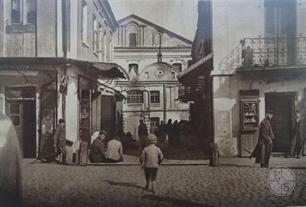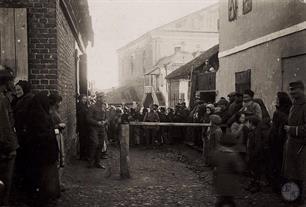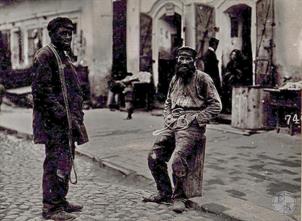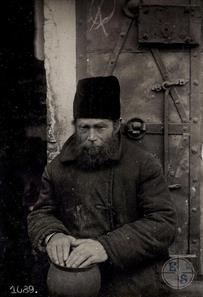Volodymyr
Sources:
- Jewish encyclopedia of Brockhaus & Efron;
- Russian Jewish encyclopedia;
- The All South-Western Territory: reference and address book of the Kyiv, Podolsk and Volyn provinces. Printing house L.M. Fish and P.E. Wolfson, 1913;
- Virtual Shtetl. Volodymyr-Volynskyi;
- Kravtsov Sergey and Vladimir Levin. Synagogues in Ukraine: Volhynia / Jerusalem: Zalman Shazar Center and the Center for Jewish Art, 2017
- Encyclopedia of Jewish Life Before and During the Holocaust, vol. 3, eds. Sh. Spector, G. Wigoder, New York 2001, pp. 1454–1455.
Photo:
- Biblioteka Narodowa Polona. Włodzimierz
- Vitalii Rogozov (2012), Eva Maria Kraiss (2018), Roman Mazurok (2020). Center for Jewish Art. Volodymyr Volynskyi
- Austrian National Library. Wladimir Wolinsky
- Wikipedia. Volodymyr
- Humus. Ethnographic pictures from the archive of the Austro-Hungarian army
- Jewish encyclopedia of Brockhaus & Efron;
- Russian Jewish encyclopedia;
- The All South-Western Territory: reference and address book of the Kyiv, Podolsk and Volyn provinces. Printing house L.M. Fish and P.E. Wolfson, 1913;
- Virtual Shtetl. Volodymyr-Volynskyi;
- Kravtsov Sergey and Vladimir Levin. Synagogues in Ukraine: Volhynia / Jerusalem: Zalman Shazar Center and the Center for Jewish Art, 2017
- Encyclopedia of Jewish Life Before and During the Holocaust, vol. 3, eds. Sh. Spector, G. Wigoder, New York 2001, pp. 1454–1455.
Photo:
- Biblioteka Narodowa Polona. Włodzimierz
- Vitalii Rogozov (2012), Eva Maria Kraiss (2018), Roman Mazurok (2020). Center for Jewish Art. Volodymyr Volynskyi
- Austrian National Library. Wladimir Wolinsky
- Wikipedia. Volodymyr
- Humus. Ethnographic pictures from the archive of the Austro-Hungarian army
Volodymyr (Ukrainian: Володимир, Yidish: לודמיר, Ludmir), previously known as Volodymyr-Volynskyi (Володимир-Волинський) from 1944 to 2021, is a small city in Volyn Oblast, northwestern Ukraine.
The city is one of the oldest towns in Ukraine. It was originally a stronghold founded by Vladimir the Great. In 988, the city became the capital of Volodymyr Principality and the seat of an Orthodox bishopric, as mentioned in the Primary Chronicle.
The medieval Latin name of the town "Lodomeria" became the namesake of the 19th century Austro-Hungarian Kingdom of Galicia and Lodomeria, of which the town itself was not a part. Five kilometres (three miles) south from Volodymyr is Zymne, where the oldest Orthodox monastery in Volynia is located.
The city is one of the oldest towns in Ukraine. It was originally a stronghold founded by Vladimir the Great. In 988, the city became the capital of Volodymyr Principality and the seat of an Orthodox bishopric, as mentioned in the Primary Chronicle.
The medieval Latin name of the town "Lodomeria" became the namesake of the 19th century Austro-Hungarian Kingdom of Galicia and Lodomeria, of which the town itself was not a part. Five kilometres (three miles) south from Volodymyr is Zymne, where the oldest Orthodox monastery in Volynia is located.
Volodymyr district, Volyn region
In 1765, 1237 Jews lived in Volodymyr-Volynsky,
in 1790 - 630,
in 1805 - 1977,
in 1847 - 3930,
in 1863 - 3953 (67%),
in 1897 - 5869 (59.3%),
in 1910 - 6853 (45%),
in 1912 - 7156,
in 1931 - 10 665 (43.5%),
In 1937 - 11 554 Jews (39%).
The earliest traces of Jewish presence in Ludmir (Pol. Włodzimierz, currently Volodymyr, Ukraine) are some the oldest in Ruthenia. The first records of Jews living in this ducal town date back to 1171. They formed a commercial community, conducting trade with merchants from vast territories – even as far as Rhineland. They enjoyed the protection of rulers, manifested in numerous privileges (except for a short period of forced exile in the years 1495–1503).
The community was headed by the famous rabbis of that time, including Itskhok ben Betsalel (1542-1576), Iehuda Leyb Altshuler, Shmuel from Tarnopol.
The community further developed after Ludmir was incorporated into Poland in 1569. The local rabbis and community leaders (parnasim) represented Volhynia at the Council of Four Lands. Among them was Yom-Tov Lipmann Heller (1579, Wallerstein – 1654, Krakуw) – an outstanding rabbi, Talmudist, and author of religious literature; in the years 1633–1644, he served as the rabbi of Ludmir (earlier he was also the rabbi of Vienna and Prague, and then of Krakow) and sat in the Va’ad in Jarosław.
The community was quickly reborn after the devastation caused by the Khmelnytsky Uprising (1648–1649).
in 1790 - 630,
in 1805 - 1977,
in 1847 - 3930,
in 1863 - 3953 (67%),
in 1897 - 5869 (59.3%),
in 1910 - 6853 (45%),
in 1912 - 7156,
in 1931 - 10 665 (43.5%),
In 1937 - 11 554 Jews (39%).
The earliest traces of Jewish presence in Ludmir (Pol. Włodzimierz, currently Volodymyr, Ukraine) are some the oldest in Ruthenia. The first records of Jews living in this ducal town date back to 1171. They formed a commercial community, conducting trade with merchants from vast territories – even as far as Rhineland. They enjoyed the protection of rulers, manifested in numerous privileges (except for a short period of forced exile in the years 1495–1503).
The community was headed by the famous rabbis of that time, including Itskhok ben Betsalel (1542-1576), Iehuda Leyb Altshuler, Shmuel from Tarnopol.
The community further developed after Ludmir was incorporated into Poland in 1569. The local rabbis and community leaders (parnasim) represented Volhynia at the Council of Four Lands. Among them was Yom-Tov Lipmann Heller (1579, Wallerstein – 1654, Krakуw) – an outstanding rabbi, Talmudist, and author of religious literature; in the years 1633–1644, he served as the rabbi of Ludmir (earlier he was also the rabbi of Vienna and Prague, and then of Krakow) and sat in the Va’ad in Jarosław.
The community was quickly reborn after the devastation caused by the Khmelnytsky Uprising (1648–1649).
 |
 |
 |
 |
| Synagogue on School Street, 1916 postcard | Aron Kodesh in the synagogue, 1917 | Aron Kodesh in the synagogue, 1917 | Amud in the synagogue, 1917 |
In the 19th century, when the area of Ludmir was under Russian rule, the town continued to be an important centre of Jewish life, with Jews constituting 2/3 of the total population. For the most part of the century, the local community remained under the influence of Hasidim from Turiisk, but Zionist circles and the Bund became active in the town in the 1890s.
In the beginning of the 19th century Ludmir became one of the centers of Hasidism.
One of the most notorious residents of Ludmir was Hanna Rachel Werbermacher (1806, Volodymyr – 1888, Jerusalem), known as the “Maiden of Ludmir” (Hebr. ha-Betula mi-Ludmir, Yidd. Ludmere Moyd). This extremely talented girl, originating from the circles of Turiisk (Trisk) Hasidim (i.e. supporters of Mordechai Twersky, the Maggid of Chernobyl), gained huge knowledge in the field of religious sciences. After her mother’s death, she devoted herself to fulfilling religious commandments and solitary life.
The rumours of her miraculous abilities quickly spread around the area. She became, as Prof. Marcin Wodziński put it, “someone like a tzaddik.” Her unusual role sparked controversy and pushed the Maggid of Chernobyl himself to intervene, which he did by forcing the “holy woman” to marry (unconsumed). Eventually, the Maiden of Ludmir left for Palestine. Her grave on the Mount of Olives is a pilgrimage site to this day.
At the same time in Ludmir was a student of Yakov-Iskhok (the Seer of Lublin) - Rabbi Noah.
In 1792, Moishe Gotlib founded in Ludmir Hasidic dynasty. After him death, his son Shloyme took his place. After the death of Shlome, his son - Nokhum, led the dynasty. The last “Lyudmir” tzadik was the son of Nokhum - Gdaliyahu.
In the beginning of the 19th century Ludmir became one of the centers of Hasidism.
One of the most notorious residents of Ludmir was Hanna Rachel Werbermacher (1806, Volodymyr – 1888, Jerusalem), known as the “Maiden of Ludmir” (Hebr. ha-Betula mi-Ludmir, Yidd. Ludmere Moyd). This extremely talented girl, originating from the circles of Turiisk (Trisk) Hasidim (i.e. supporters of Mordechai Twersky, the Maggid of Chernobyl), gained huge knowledge in the field of religious sciences. After her mother’s death, she devoted herself to fulfilling religious commandments and solitary life.
The rumours of her miraculous abilities quickly spread around the area. She became, as Prof. Marcin Wodziński put it, “someone like a tzaddik.” Her unusual role sparked controversy and pushed the Maggid of Chernobyl himself to intervene, which he did by forcing the “holy woman” to marry (unconsumed). Eventually, the Maiden of Ludmir left for Palestine. Her grave on the Mount of Olives is a pilgrimage site to this day.
At the same time in Ludmir was a student of Yakov-Iskhok (the Seer of Lublin) - Rabbi Noah.
In 1792, Moishe Gotlib founded in Ludmir Hasidic dynasty. After him death, his son Shloyme took his place. After the death of Shlome, his son - Nokhum, led the dynasty. The last “Lyudmir” tzadik was the son of Nokhum - Gdaliyahu.
 |
 |
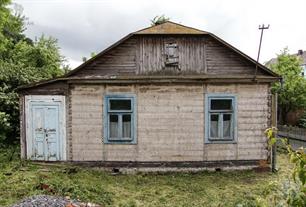 |
| Shulman’s Synagogue in Volodymyr, 2018. Lutska Street, 81 | Akiva Clubhouse and Synagogue in Volodymyr, 2012. Pidzamche Street |
World War I wreaked havoc in the town. In 1915, its population was forced to evacuate. A cholera epidemic broke out, and people suffered from acts of violence committed by Russian Cossacks.
In 1921, there were 5,917 Jews living in Ludmir, accounting for 50.9% of the population.
In the period of the Second Polish Republic, the community began to be revived, as did the whole town. The help of the Joint Distribution Committee played an important role in the process.
In the 1920-30s there were approx. 20 synagogues in Ludmir. The Rabbi in the 1920s - early 1930s was Itskhok Aizik Grosman, in the 1930s - Yakov Dovid Morgenstern (? –1941).
In 1931, there were 10,665 Jews living in the town and the total population reached 24,591.
In 1925, the Tarbut school was opened (500 students). A private Jewish gymnasium worked with teaching in Polish, yeshiva acted (138 students).
In 1936, a 2-year agricultural school with teaching in Hebrew opened.
On 17 September 1939, the Red Army entered the town. The Soviet occupation disorganised the social and economic life of Ludmir.
In 1921, there were 5,917 Jews living in Ludmir, accounting for 50.9% of the population.
In the period of the Second Polish Republic, the community began to be revived, as did the whole town. The help of the Joint Distribution Committee played an important role in the process.
In the 1920-30s there were approx. 20 synagogues in Ludmir. The Rabbi in the 1920s - early 1930s was Itskhok Aizik Grosman, in the 1930s - Yakov Dovid Morgenstern (? –1941).
In 1931, there were 10,665 Jews living in the town and the total population reached 24,591.
In 1925, the Tarbut school was opened (500 students). A private Jewish gymnasium worked with teaching in Polish, yeshiva acted (138 students).
In 1936, a 2-year agricultural school with teaching in Hebrew opened.
On 17 September 1939, the Red Army entered the town. The Soviet occupation disorganised the social and economic life of Ludmir.
In the 2nd half of the 19th century there were 7 synagogues in Ludmir, mostly Hasidic.
In 1888, a Jewish hospital was built. Then the Talmud-Torah and a public school for Jews were opened.
From the end of the 19th century the department "Hibat Zion" was operated in Ludmir, since 1906 -Bund and Zionist Socialist.
In 1897, Ludmir had 5,869 Jewish inhabitants, accounting for 59.3% of the population. They earned their living from trade, craftsmanship, and small-scale production. The manufacturing of clothing and trade in grain and cattle played an important role in the life of the community.
In the 1900s yeshiva was founded.
In 1888, a Jewish hospital was built. Then the Talmud-Torah and a public school for Jews were opened.
From the end of the 19th century the department "Hibat Zion" was operated in Ludmir, since 1906 -Bund and Zionist Socialist.
In 1897, Ludmir had 5,869 Jewish inhabitants, accounting for 59.3% of the population. They earned their living from trade, craftsmanship, and small-scale production. The manufacturing of clothing and trade in grain and cattle played an important role in the life of the community.
In the 1900s yeshiva was founded.
 |
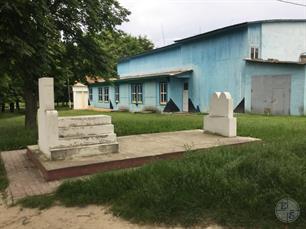 |
 |
| Ohel of Rabbi Shlomo of Karlin on the site of the Jewish cemetery in Volodymyr, 2019 | Site of the Jewish cemetery in Volodymyr, 2019 | Former girls school Beit Yakov, 2016. Street Dragomanova, 9 |
On 23 June 1941, the town was seized by the Germans. Their arrival was preceded by heavy bombardment which resulted in numerous casualties.
On 7 July 1941, the Judenrat was established in the town and tasked with supplying workforce for the Germans. Mass executions soon followed: 31 July 1941 – 200 victims; 29–30 August 1941 – 300 victims; 29 September 1941 – 250 victims; October 1941 – groups of 120 intellectuals and 500 and 600 workers.
On 13 April 1942, the Jews still remaining in Ludmir, including a large number of refugees, were imprisoned in a ghetto. In May 1942, they were divided into “productive” and “unproductive” individuals. On 1 September 1942, 4,000 people from the latter group were murdered.
By 15 September 1942, Germans murdered another 14,000 Jews in a series of mass executions held over open pits near the village of Pyatydni.
After these, there were still 4,000 Jewish people left in Ludmir – qualified workers and those who came out of hiding. They were murdered on 13 November 1942 and 13 December 1943. Very few of them managed to escape and join the partisans, including Home Army units.
On 7 July 1941, the Judenrat was established in the town and tasked with supplying workforce for the Germans. Mass executions soon followed: 31 July 1941 – 200 victims; 29–30 August 1941 – 300 victims; 29 September 1941 – 250 victims; October 1941 – groups of 120 intellectuals and 500 and 600 workers.
On 13 April 1942, the Jews still remaining in Ludmir, including a large number of refugees, were imprisoned in a ghetto. In May 1942, they were divided into “productive” and “unproductive” individuals. On 1 September 1942, 4,000 people from the latter group were murdered.
By 15 September 1942, Germans murdered another 14,000 Jews in a series of mass executions held over open pits near the village of Pyatydni.
After these, there were still 4,000 Jewish people left in Ludmir – qualified workers and those who came out of hiding. They were murdered on 13 November 1942 and 13 December 1943. Very few of them managed to escape and join the partisans, including Home Army units.
 |
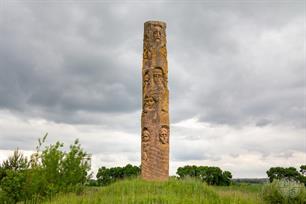 |
 |
| Holocaust memorial, 2016. Shevchenka Street | Holocaust Memorial in Piatydni near Volodymyr, 2020 | Tombstone from Volodymyr cemetery,2020 |
The local economy was boosted by the opening of a railway connection with Kovel in 1906.
In 1913, more than 340 shops in the town (almost all) belonged to Jews. Jews also owned the only warehouse of kerosene, one of the two brick factories, the only sawmill, both hairdressers, all 7 inns, laundry, 5 taverns, all 4 studies of photos, 1 of 3 pharmacies, the only beer warehouse.
All 8 timber industrialists, the only jeweler, all 3 tailors, 2 of 14 doctors and all 4 dentists were Jews.
Interestingly, a Jewish entrepreneur was even engaged in buying pigs.
Jewish hospital, Jewish almshouse, Jewish library and credit society acted in Ludmir.
In 1913, more than 340 shops in the town (almost all) belonged to Jews. Jews also owned the only warehouse of kerosene, one of the two brick factories, the only sawmill, both hairdressers, all 7 inns, laundry, 5 taverns, all 4 studies of photos, 1 of 3 pharmacies, the only beer warehouse.
All 8 timber industrialists, the only jeweler, all 3 tailors, 2 of 14 doctors and all 4 dentists were Jews.
Interestingly, a Jewish entrepreneur was even engaged in buying pigs.
Jewish hospital, Jewish almshouse, Jewish library and credit society acted in Ludmir.

- Home
- Shtetls
- Vinnytsia region
- Volyn region
- Dnipro region
- Donetsk region
- Zhytomyr region
- Zakarpattia region
- Zaporizhzhia region
- Ivano-Frankivsk region
- Kyiv region
- Kropyvnytskyi region
- Luhansk region
- Lviv region
- Mykolayiv region
- Odessa region
- Poltava region
- Rivne region
- Sumy region
- Ternopil region
- Kharkiv region
- Kherson region
- Khmelnytskyi region
- Chernihiv region
- Chernivtsi region
- Cherkasy region
- Crimea
- Synagogues
- Cemeteries
- Objects & guides
- Old photos
- History
- Contact
Jewish towns of Ukraine
My shtetl
My shtetl
Donate
Jewish towns of Ukraine



